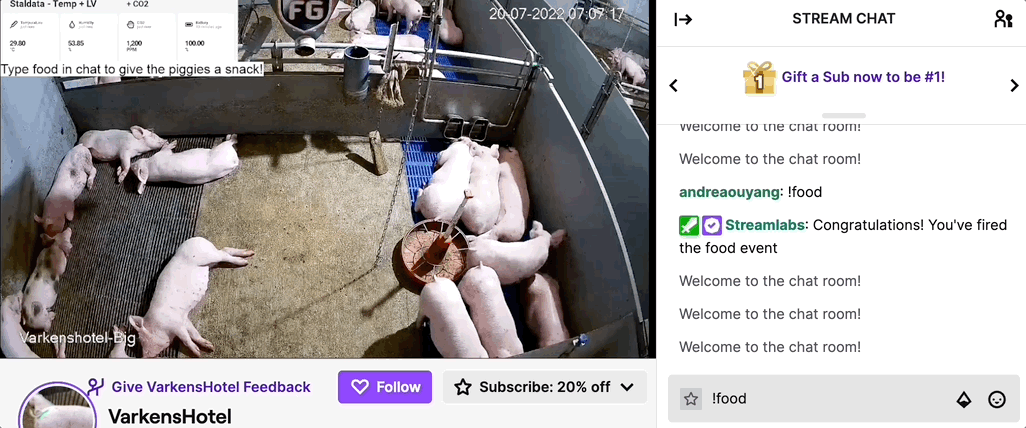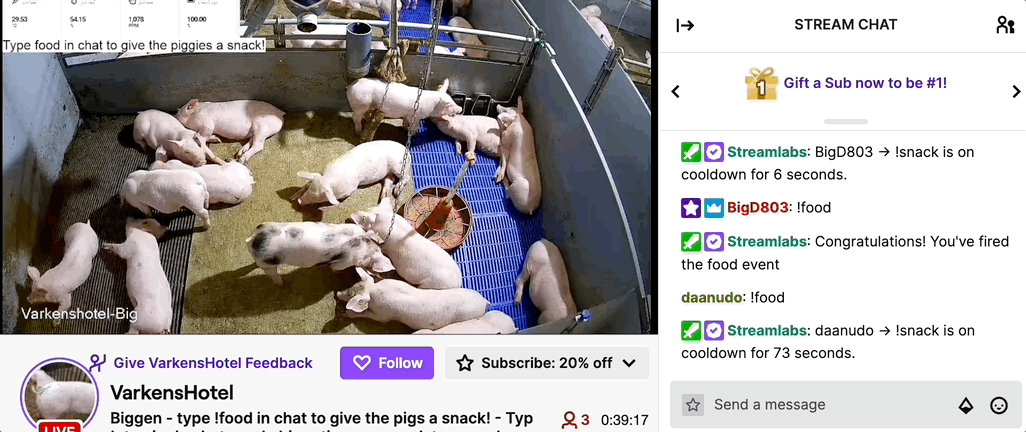Live streaming has become very popular, but have you ever seen a pig live stream?
Let’s see how it works!
Who are they?
Based in the Netherlands, Stal Data is a technology solutions company for farmers. Its founder pays attention to monitoring animal behavior and living environment to provide a technical solution to farmers and improve the well-being of the pigs. This process is also shown to the public through live streaming.

(Tips: The live link is at the end of the article.)
How did they build this whole network?
- Deploying a Helium gateway
- Deploying SenseCAP sensors
- Checking data on the web and SenseCAP Mate App

(4. Displaying data on the stream for Long term remote monitoring and management)

Why did they do this?
1. CO2 concentration, temperature, and humidity
Intensive pig farming is an industry where a lot of parameters are important. In the early days, farmers mainly focused on the feed. Nowadays, farmers realize that climate is also a big part of the behavior of pigs and their health and growth.
SenseCAP S2103 Wireless LoRaWAN CO2, Temperature and Humidity Sensor
Monitoring temperature and humidity are important in pig farming to understand what is going on with the climate inside of the barn. An example that Stal Data experienced on their farm was that in the rear of the rooms in the barn, the air was very hot and humid. At that time, they placed 12 temperature and humidity sensors inside the room. By measuring the temperature and humidity, they found that the temperature in the rear end of the room was always 5 degrees higher than in the front of the room, where the air gets sucked out of the room. After that, they placed an extra ventilator in the rear end of the room to push the air to the front of the room. Now the temperature is almost equal throughout the room.

By measuring CO2 concentrations, Stal Data can check the minimum ventilation of the ventilation system. The minimum ventilator must be set in such a way that the CO2 concentration never exceeds 3000ppm CO2. When there are more than 3000ppm CO2, the minimum ventilation percentage must be set higher. Besides, when the CO2 is higher in the front of the room than in the rear of the room, it means that the front of the room does not get as much clean air as the part of the room with the lower CO2 concentration. In this way, they can check if the air is distributed equally across the room in the barn.
2. Ammonia (NH3) concentration
Monitoring ammonia gas is also very important, SenseCAP also provides the S2100 LoRaWAN® DTU and NH3 sensor. Ammonia is very irritating to the mucous membranes of the pigs. For piglets, the concentration should be lower than 8ppm ammonia. After they are 30 kilos, the concentration should be lower than 15ppm ammonia.
Why SenseCAP?
“We have used many different CO2 sensors. The main advantages of the SenseCAP sensor are the resistance to water and ammonia. They won’t be easily damaged in humid environments or environments with lots of ammonia. Another benefit is the resistance of the sensor to vibrations. They are very resilient. Compared with other sensors, these CO2 sensors have batteries and are therefore completely wireless. And the SenseCAP can work for many years without replacing the battery. Besides, the sensors are very portable, due to their small size they can easily be located in another spot. They are also very lightweight and can be fixed with a simple tie wrap.” — Stal Data
Part of the tests that we have conducted on the devices
Who are we?
We are participants in IoT applications. You may find that those piglets are all very healthy and lovely under this management. Animal health is particularly essential. The well-being of animals is the responsibility and primary concern of every farmer. But IoT applications aren’t just for animal husbandry. Hope this article can provide you with a reference to build a remote management network in other industries. Making technology readily available is always our original intention. If you want to share your story with SenseCAP sensors like Stal Data, please feel free to contact us: [email protected]
If you’re keen to learn more about SenseCAP LoRaWAN sensors, you might be interested in reading the following product description:
SenseCAP S2101 Wireless LoRaWAN® Air Temperature and Humidity Sensor
SenseCAP S2102 Wireless LoRaWAN® Light Intensity Sensor
SenseCAP S2103 Wireless LoRaWAN® CO2, Temperature, and Humidity Sensor
SenseCAP S2104 Wireless LoRaWAN® Soil Moisture and Temperature Sensor
SenseCAP S2105 Wireless LoRaWAN® Soil Moisture, Temperature and EC Sensor
SenseCAP S2100 LoRaWAN® Data Logger
If you’ve been attracted by these lovely piggies, type food in chat to give them a snack!

Notes: This article’s written by Andrea Ouyang, edited and posted by Haihua Liu.


